Blue whales are the largest animal species to ever roam the earth, weighing in at over 330,000 pounds! Even baby blue whales are colossal animals and weigh nearly 6,000 pounds when they are born. That is like having a baby that’s bigger than an adult rhinoceros! Despite their large size, however, blue whales are gentle giants and live in nearly every ocean across the earth except for the Arctic. Learn more about these extraordinary animals with 10 incredible blue whale facts!

1. The Blue Whale is the Largest Animal on the Planet
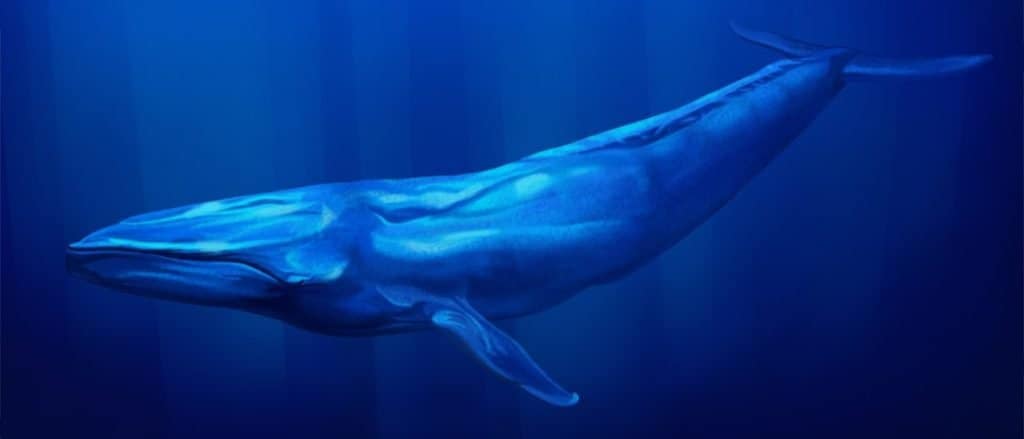
Blue whales are the largest animal on the planet and the largest blue whale ever recorded was just over 111 feet long!
©Atomic Roderick/Shutterstock.com
Not only is the blue whale the largest animal on the planet today, but it is also one of the largest animals ever to have existed on Earth! One of the coolest blue whale facts is that this colossal creature can grow over 100 feet long. That is longer than three triceratops standing head to tail, or about as long as three school buses. Blue whales weigh 200 tons, which is about as heavy as fifteen school busses!
One of the reasons a blue whale can grow so large is because it lives entirely in the ocean. Animals on land are limited by gravity, because their skeletons need to be able to support their large bodies. In the ocean, however, the water’s buoyancy counteracts the pull of gravity. This allows a blue whale to grow much larger than what its skeleton could feasibly support on land.
2. Blue Whales are Mammals
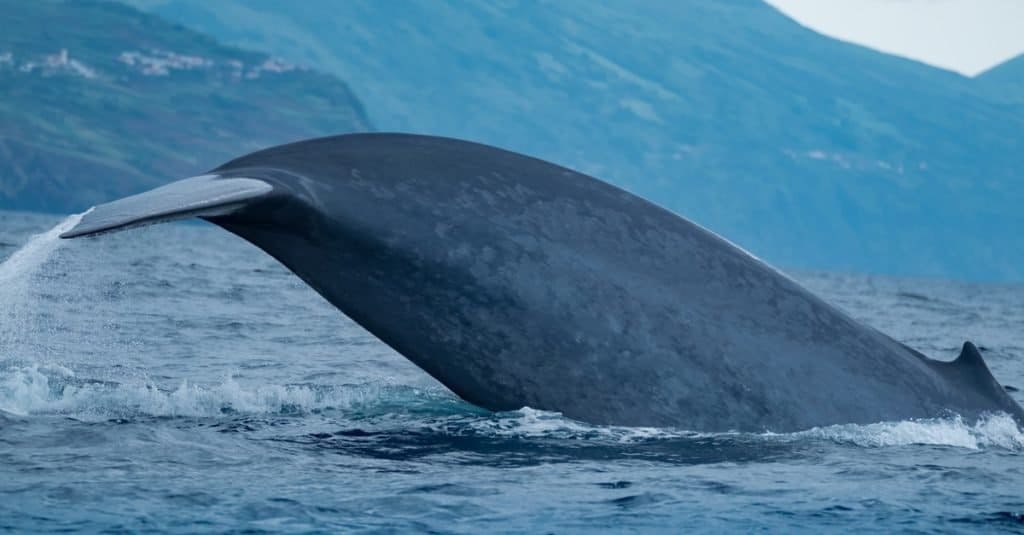
The biggest animal in the world, a blue whale breach, showing its back from dorsal fin to tail flukes.
©Wild_and_free_naturephoto/Shutterstock.com
Even though they live their entire lives in the ocean, blue whales are mammals. They are warm-blooded, give live birth, and nurse their babies with milk. Their prehistoric ancestors, wolf-like creatures called Pakicetus, began to hunt in the water around 50 million years ago. Over time these animals became more adapted to life in water, and over millions of years they eventually evolved into the baleen whales that we see on earth today.
Because whales descended from mammals that had limbs under their bodies, their backbones still bend up and down rather than side to side. Their tails are horizontal rather than vertical like fish tails, helping them to swim using this up and down motion.
3. Blue Whales Eat A Lot

Blue whales use their large, extendable mouths to capture thousands of krill at a time.
©bekirevren/Shutterstock.com
Blue whales need a lot of food to sustain their large size. However, the prey that blue whales eat is incredibly small. Blue whales eat krill, which are tiny crustaceans that are only 2-4 inches long! This means that a single blue whale needs to eat a lot of krill to make a full meal. These behemoth whales can eat up to 4 tons of krill every day! That is even more than an African elephant weighs.
When a blue whale comes upon a group of krill floating in the ocean, it opens its mouth almost 90 degrees. Its lower jawbone is split, allowing it to stretch its mouth wide like a large fishing net and scoop up thousands of swarms of krill. The whale then uses its tongue to squeeze the water out through the baleen bristles lining its upper jaw, leaving only the filtered krill behind.
4. A Blue Whale’s Earwax Can Reveal Its Age
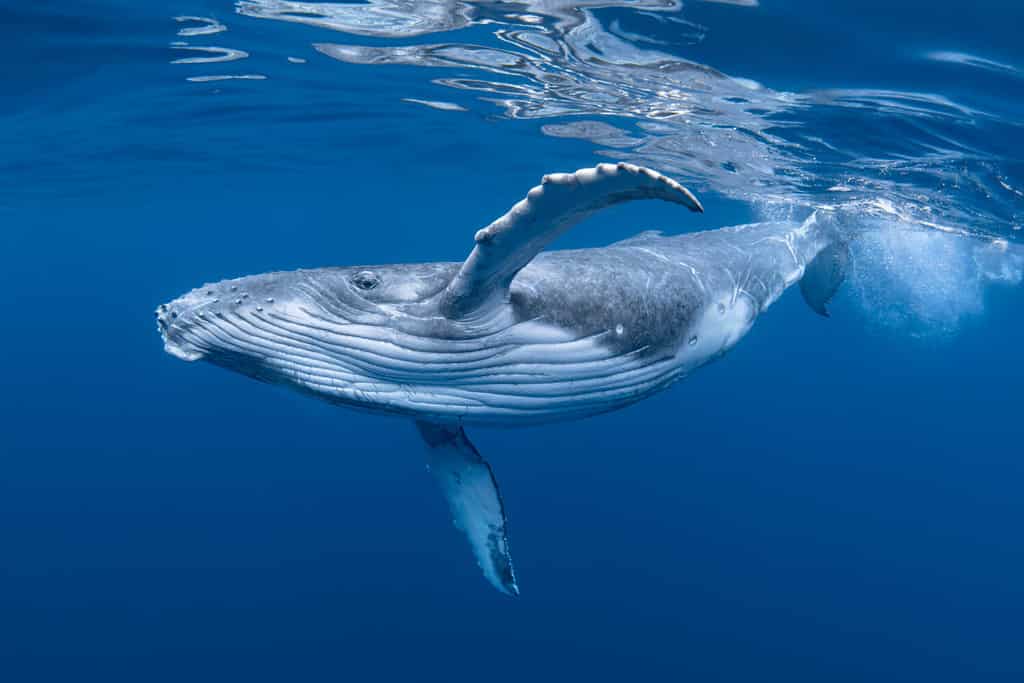
The wax buildup in a blue whale’s inner ear is called an “earplug”.
©Craig Lambert Photography/Shutterstock.com
Every six months or so, a new layer of earwax forms inside of the ear canals of a blue whale. This wax helps to carry sound waves and protect the whale’s inner ear. The wax buildup in a blue whale’s inner ear is called an “earplug”. A rather incredible blue whale fact is that scientists can study earplugs from dead whales to measure and estimate how old the whale was. A blue whale’s earplugs are kind of like the rings in a tree trunk, just a bit stickier. Generally blue whales live around 80-90 years, but one earplug measured by scientists suggests that its owner was around 110 years old!
5. The Blue Whale is the World’s Loudest Animal
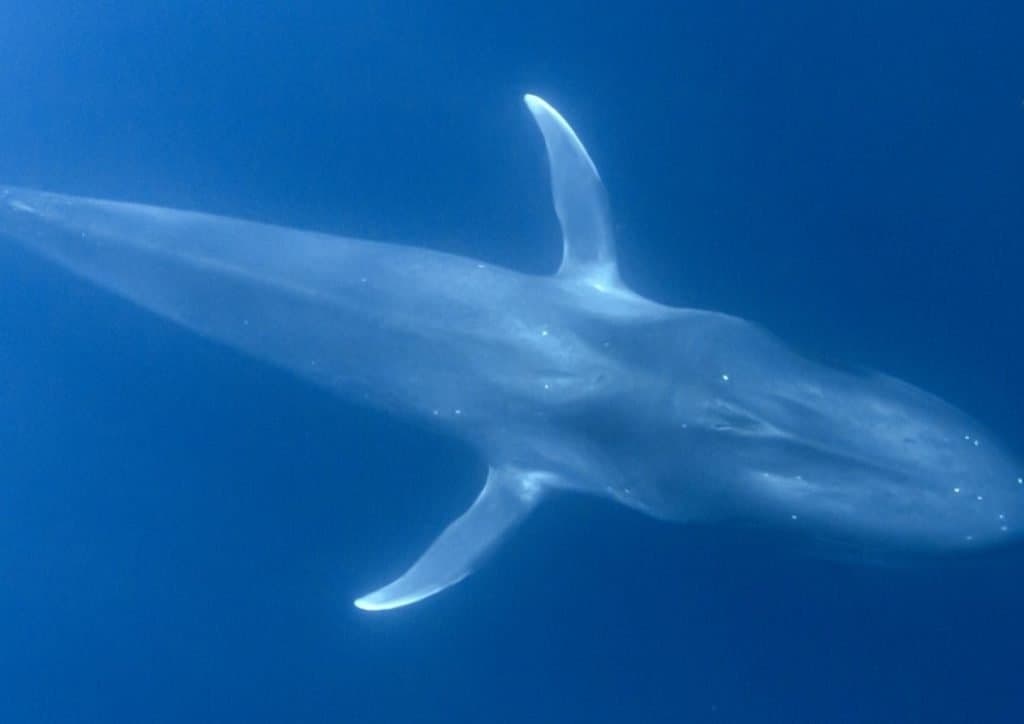
A blue whale’s song can measure up to 188 decibels. That is louder than a jackhammer (100 decibels) and even a jet engine (140 decibels).
©Rich Carey/Shutterstock.com
Blue whales have excellent hearing and communicate with one another using low frequency pulses, deep moans, whistles, rumbling noises, and groans. These whale songs are louder than a jet engine and measure up to 188 decibels! Blue whales use these sounds to communicate with one another over vast distances. Their incredible whale songs have been recorded from over 500 miles away!
6. Blue Whales Have Big Hearts
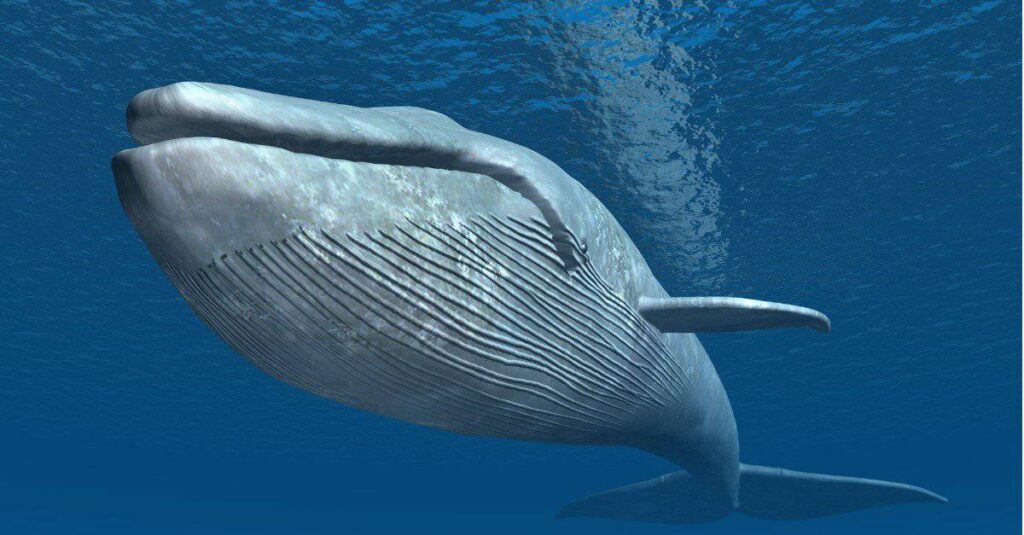
Blue whale hearts are four feet wide!
©iStock.com/MR1805
You may have heard that blue whales have hearts as big as a car, or that their arteries are big enough for an adult human to swim through. However, these are only urban legends. A blue whale’s heart isn’t quite that big, but it is still very large. It is about 5 feet tall, 5 feet long, and 4 feet wide, and weighs around 400 pounds. Even at 400 pounds though, a blue whale’s heart is still only 1% of its overall body weight!
For comparison, think about the African elephant, the largest land animal in the world. Its heart weighs around 30 pounds and is about 5% of its entire body weight. Humans on the other hand, have hearts weighing less than a pound (only around 10 ounces).
7. Blue Whales Have Small Families and Big Babies
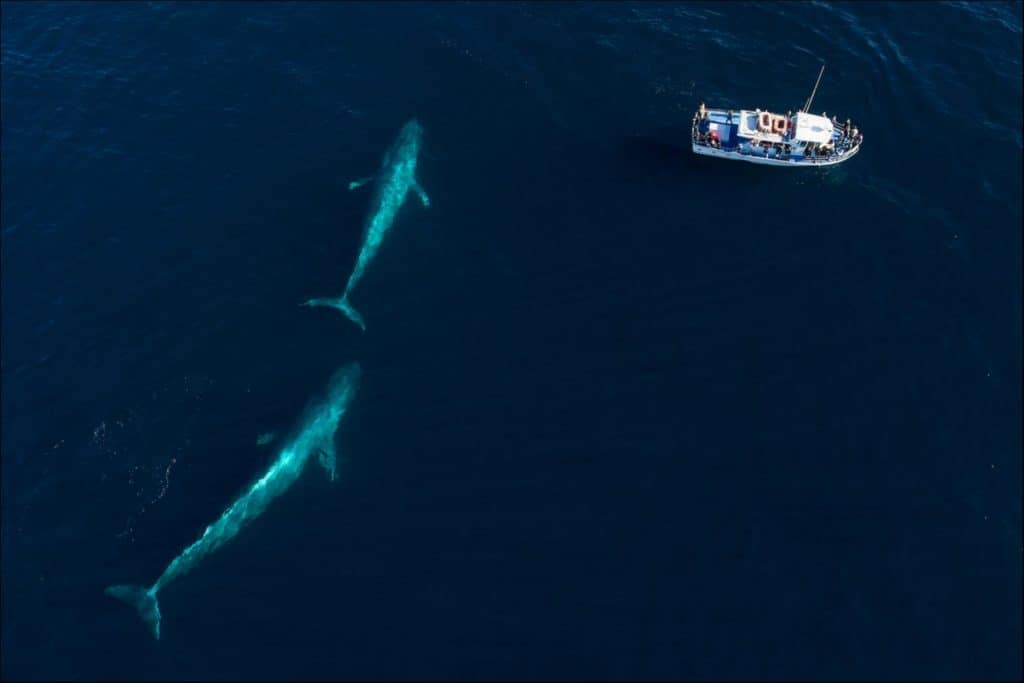
Blue whale mothers nurse their calves for the first 6-7 months.
©Chase Dekker/Shutterstock.com
Blue whales usually travel alone or in pairs, although occasionally they may come together to form small groups when food is abundant. When they are around 10 years old, blue whales will begin breeding, and mature female whales can produce one baby whale, or calf, every 2-3 years. Females are pregnant for 10-12 months and give birth to only one calf. When a blue whale calf is born, it may already be 23 feet long!
Mothers are very attentive and nurturing to their young calves and the two share a special bond. Baby blue whales have large appetites and can drink over 50 gallons of milk from their mothers every day! Blue whale milk is full of nutritious fats and proteins. In fact, it is about 13% protein and 40% fat. Human breast milk, on the other hand, is only 1% protein and 4% fat. In just the first 5-7 months of life, a baby blue whale will gain around 38,000 pounds.
8. Blue Whales Have Two Blowholes

As the blue whale’s ancestors evolved from land mammals into marine mammals, their nostrils migrated from the end of their snouts back to the top of their head. Today, blue whales have two blowholes right next to each other, just like a giant nose!
Blue whales only need to lift the top of their heads above water to breathe through this double-nostril blowhole. After they take a breath, a flap closes over the two holes before they return underwater, sealing them up so that water does not get inside. Blue whales generally surface every 30 minutes or so for a breath of air, but they can hold their breath for up to 90 minutes at a time.
9. Whale Baleen Was Popular in 19th century fashion
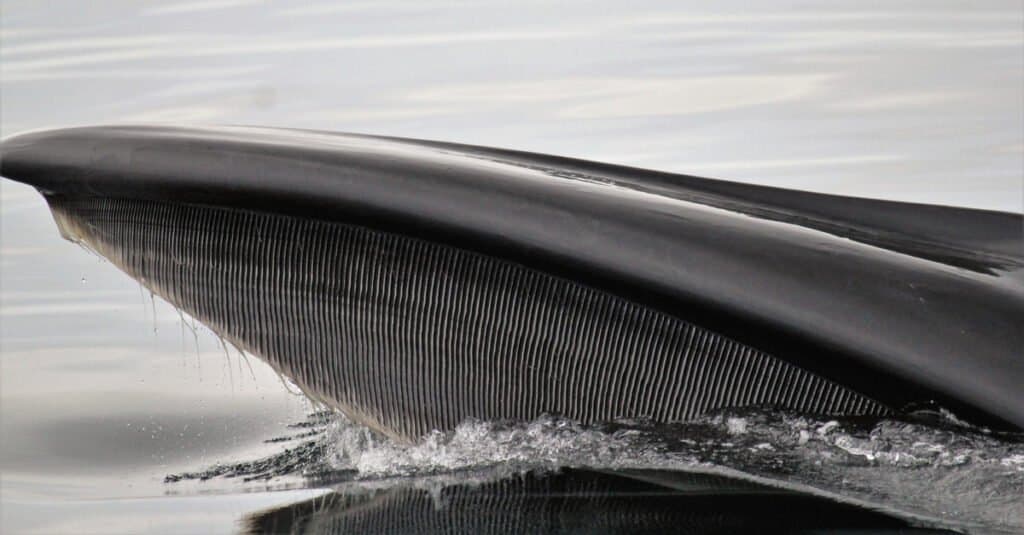
Here’s an incredible blue whale fact: they don’t have any teeth! Instead blue whales have hundreds of bristle-like baleen plates made out of keratin that help them to filter food when they eat.
©Sharlyn/Shutterstock.com
Like other baleen whales, blue whales have bristly “baleen plates” instead of teeth. These baleen plates are made of keratin, the same flexible substance that our fingernails are made of. This helps whales to filter water while keeping food in when they gulp in swarms of krill.
During the 19th century, whale baleen became a popular material for structuring women’s clothing because of its strength and flexibility. The fashion industry called it “whale boning”, and used it to structure corsets, collars, hooped frames in skirts, and hat brims. Unfortunately, the demand for whale baleen and other whale parts became so great that blue whales were aggressively hunted and nearly went extinct.
10. Only 3-11% of Past Blue Whale Populations Remain today

Some blue whales stay in the same general area throughout the year, while others feed near polar waters during the summer, and migrate toward the equator before winter.
©Andrew Sutton/Shutterstock.com
It was not until the 1960’s that global bans on whale hunting were put into place, but by then blue whale populations were already severely depleted. One of the saddest blue whale facts is that today their population is only 3-11% of what it was before the 19th century. In some areas blue whales are slowly making a comeback. However, they are an endangered species and around 1,500 are still killed each year. Dangers like climate and environmental change, pollution, being hit by large ships, habitat loss, illegal poaching, and getting entangled in fishing gear, continue to threaten these magnificent sea creatures. Hopefully these beautiful and gentle whales will continue to grow and we will see more of them in the future.
The photo featured at the top of this post is © iStock.com/MR1805
Thank you for reading! Have some feedback for us? Contact the AZ Animals editorial team.






